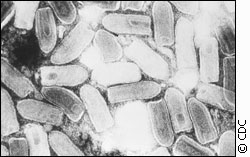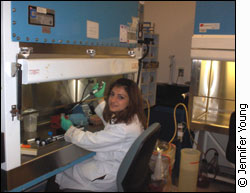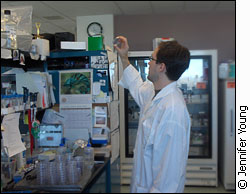
|
|
A number of scientists are currently testing the effects of viruses on cancer cells and are getting very encouraging results.
John Bell, a professor at the University of Ottawa and physician at the Centre for Cancer Therapeutics, is a member of a group testing the vesicular stomatitis virus on cancer cells. Vesicular stomatitis virus is normally contracted by mammals, mainly livestock. It is most often contracted though sand fly or mosquito bites. It is relatively benign and usually manifests as flu-like symptoms. In theory, a virus like the one Bell is using could be used to treat different kinds of cancer in patients. "It would be injected intravenously so it would have access to the entire body," Bell says. It then works its way through the patient’s blood stream and eventually kills all of the cancer cells. "No matter where the cancer is, it can attack," says Bell. "No matter where the tumor is hidden, the virus will have a chance to infect it." The virus should infect the cancerous cells but leave the healthy ones alone because they lack the defect found in the infected cells. "We discovered that some of the genetic changes in current cancer cells renders them potentially sensitive to virus infection. Whereas normal counter parts, of the same tissue, would be resistant," Bell says. How it works The pathway that frequently exhibits defects in tumor cells is called the interferon signaling cascade. Because pathways in the cancer cells are altered, the virus can get into the cell and replicate.
Healthy cells are protected by an interferon, which prevents the virus from infecting the cell. This virus is very sensitive to interferon. The cancerous cells are interferon-insensitive which is what allows the virus to infect them. It’s almost like the difference between waterproof and non-waterproof shoes. If the shoe is protected the water can’t get in, but if not the water is able to seep in and ruin the shoes. The cancer cells’ lack of interferon protection allows the virus to seep in and kill the cells. Eventually the virus replicates to a point that the cell can no longer contain it. The cell bursts and dies — releasing the replicated virus that continues to make its way through the system. In order to use the virus in the experiment and eventually in the treatment, it must first be produced. Bell makes the virus by allowing cells to replicate until there are litres and litres of them. He then injects the tissue cells with the virus and allows it to remain in the tissue for a day.
"A virus can’t grow outside of the cell," Bell says. He related it to sneezing on a coffee table and how the virus can’t grow on that, which is why people don’t become ill from touching the same table a few days later. Much like recovering from a cold, the virus will leach out of the cell. At this point, the virus is harvested and then purified. With a pure virus, Bell can perform his tests. He is currently in the process of testing the treatment on rats and human cancerous cells in test tubes. Success The treatment had been tested on leukemia as well as breast, colon, and prostate cancers. "About 80 per cent of the cancers that we have looked at, of all kinds, seem to have the particular defect this virus can exploit," Bell says. The benefit of this treatment is that it can find and kill cancer cells that the patient isn’t even aware exist. Cancer often spreads to other parts of the body; known as metostatic disease. It is difficult to ensure all the cancer is removed through surgery or chemotherapy. However, because the virus goes through the patient’s entire blood stream it attacks all of the cancer cells it finds.
Bell is hoping to test his work on humans. He had estimated that trials on humans would begin in late February or early March of this year, but his plan is slightly delayed because of funding. Similar treatment is, however, approved for testing on neck and head cancers on people in China. "Our objective is to find a new therapeutic that will actually change the way cancer’s being treated," says Bell. "We also recognize that it might not work." Bell acknowledged that there are some risks to the treatment. "There is the risk that if we have not understood (the virus) correctly, it could grow uncontrolled and affect the patient." Bell admitted that there was a chance that this could happen but that he haven’t experienced this in his research. "The beauty of these viruses is that since we understand them genetically, if it’s not working as well as we want it to when we test on people, we can go back to the lab and change its genetic composition and test it again," Bell says. A different virus, a different scientist Another member of the group researching virus’ effects on cancer is Grant McFadden. He is a researcher at the Robarts Research Institute and the University of Western Ontario. "I’m newcomer to the virus game," McFadden says. McFadden is testing the myoma virus. This virus is deadly to rabbits but appears to be non-fatal to rats. After discovering this, McFadden decided to look at why this might be. He discovered that the reason it could kill rabbits was that their cells contained the same defect in their cell pathways as human cancerous cells.
He and Peter Forsyth of the University of Calgary studied this treatment and how it works on gliomas, which are brain tumors. He has had similar success in treating cancer in lab animals as Bell. "The virus can infect and cure about two-thirds to three-quarters of the cancer," said McFadden. He stressed, however that his research is still at a very early stage. McFadden has tested the effects of the treatment on gliomas in immune deficient animals but wants to test the treatment effects on animals with a healthy system. "I’m hopeful as we move into further animal models we will be able to treat a large fraction of cancer in the host," said McFadden. Looking to the future Bell and his colleagues are planning to continue their research and hope to get the viral treatment approved for testing on people. "My personal belief is that this kind of therapeutic … is going to change the way cancer is treated in the future," said Bell.
|
|
|


